We've all figuratively floated into the kitchen because of its aroma at some point in our lives. Our parents would prepare delicious meals for us, and we couldn't wait to gobble them all.
However, we would rarely pay any attention to the kind of utensils that were used. However, those who did would discover that stainless steel was frequently the preferred material.
For a long time, stainless steel has established a presence in Indian kitchens due to its durability. Now, we would like to introduce you to tri-ply stainless steel cookware. It's a relatively new concept in the country, but it's swiftly finding its way into many Indian households.
As the name suggests, tri-ply cookware has three layers. The innermost layer is made of stainless steel, the middle one consists of aluminium and the outermost layer consists of, again, stainless steel. This distribution of different layers helps in maximising heat transfer and retention across the surface of the tri-ply cookware.
Aluminium is a great heat conductor and it ensures that the heat is distributed evenly. This reduces the chances of food burning and makes cooking easier in this triply cooking range. The extra layer of stainless steel ensures that food doesn’t come in contact with the aluminium layer.

Why should you choose stainless steel and tri-ply stainless steel cookware?
The Indus Valley tri-ply stainless steel cookware comes with a treasure trove of benefits. Allow us to tell you about them all:
Naturally non-stick
This cookware range is unlike any regular non-stick cookware set. It does not have a film of non-stick material, but it can still lower the chances of your food getting burnt by sticking to the surface. How, you ask? Well, the layer of aluminium in it ensures that the heat is evenly distributed rather than concentrating all the heat in one area of the utensil.
Compatible with induction cooking
At The Indus Valley, our tri-ply steel cookware’s outermost layer of steel is magnetic. It is the best choice if you have moved away from the traditional LPG cooktops and are looking for utensils to work with your induction cooktop.
Even heating
The central aluminium layer of tri-ply cookware aids in quick and even heat conduction throughout the surface of the utensil, reducing "hot spots" and boosting cooking performance.
Durable
Unlike a non-stick Teflon pan, you don't have to worry about tri-ply cookware getting scratched. The stainless steel layer of tri-ply cookware remains unscathed and useful even when it gets used and scratched for an extended period. Tri-ply cookware is built to last and can easily last decades if properly cared for. It has a greater melting point; thus it keeps its shape and cooking capabilities long.
Cleaning
Cleaning tri-ply cookware is an easy affair. Even a simple solution of warm water and a gentle wipe should suffice. Steel wool can also be used to scour the pan. Scratching may occur as a result. The cookware, on the other hand, remains totally usable.
Non-reactive to acidic foods
So many people want to cook tomato sauce and other acidic foods, but they don't because they're afraid of their cookware interacting with the meal and generating contaminants. There is no chance of toxic chemicals tainting your food when it comes to using tri-ply stainless steel. It is non-reactive and won't lead to your food becoming harmful for consumption.
Great value for money
Regular cooking utensils last a few years, but tri-ply stainless steel cookware will last for a long time. Some would say that this cookware can also be a family heirloom.
How to take care of stainless steel cookware?
The key to maintaining your stainless steel cookware is to clean it immediately after cooking. If you are cooking with oil, it will start to build upon the bottom of the pan and will become sticky. In order to remove this, use a non-abrasive sponge or scrubber and scrub the pan.
This will remove the oil and make it shiny again. If you are cooking with a tomato-based sauce, you can use a little dish soap to remove the stickiness. After you have scrubbed the stainless steel cookware, you should rinse it and dry it.
The next step is to apply a thin layer of cooking oil to the bottom of the pan. This will prevent the food from sticking to the pan and will also prevent rusting. If you want to maintain the shine of your stainless steel cookware, you should periodically use a polishing pad or a metal polishing cloth.
This will bring back the shine and make your cookware sets look new.
Things to remember while purchasing stainless steel cookware
In case you need more help with choosing the right stainless steel cookware, you can get in touch with us at The Indus Valley. We would be happy to assist you in the best possible way.
The Indus Valley Stainless Steel Cookware
The Indus Valley Stainless Steel Cookware is a frontrunner when it comes to providing healthy, safe to use quality cookware to Indian households. Our cooking range offers the benefits of being a health-focused and safe cookware company. With our triply stainless steel utensils, cooking is a hassle-free experience.
Furthermore, The Indus Valley has a beautiful range of naturally non-stick cookware set options. All of them are made from natural materials like cast iron, iron, copper, bronze, wood, brass and clay.
The beautiful and sleek designs are durable and sturdy and easy to clean. The cookware sets are perfect for the home chef or novice cook and they are also perfect for someone who is looking for an affordable, high-quality cookware set.
Common Questions About Triply Cookware
Which is better? Tri-ply or stainless steel?
Tri-ply, of course! Stainless steel alone is not a good conductor of heat. Tri-ply cookware, on the other hand, is a type of stainless steel that comes with two layers of stainless steel and one layer of either aluminium or copper.
Does tri-ply come in a non-stick option?
It is not non-stick, but it is quite low-stick. However, there are some tri-ply cookware options that do come with a layer of Teflon or Greblon. This is the non-stick cookware set option. Even if you are using the normal version, it reduces the chances of your food burning.
What purpose does the aluminium layer serve?
Aluminium is a good conductor of heat and helps it to be distributed evenly in the container. This means that there are lesser chances of the food getting burnt.
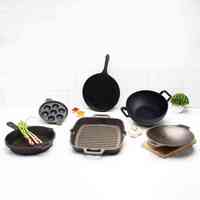


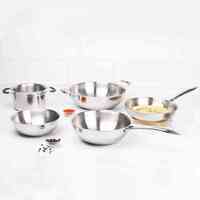
 Easy 7-Day Return
Easy 7-Day Return
 Additional ₹100 Off on Prepaid Orders*
Additional ₹100 Off on Prepaid Orders*




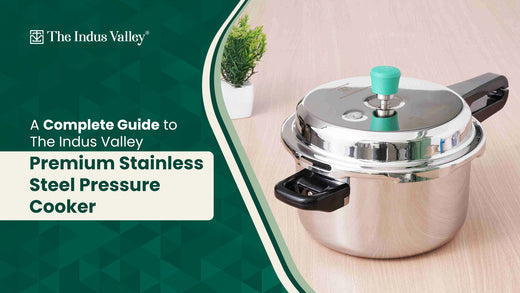


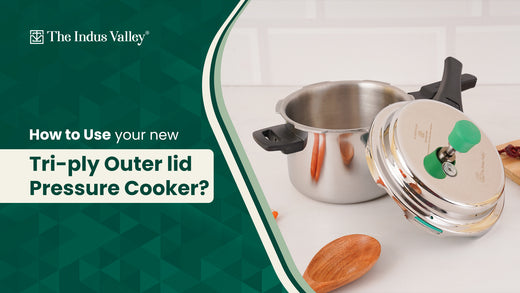



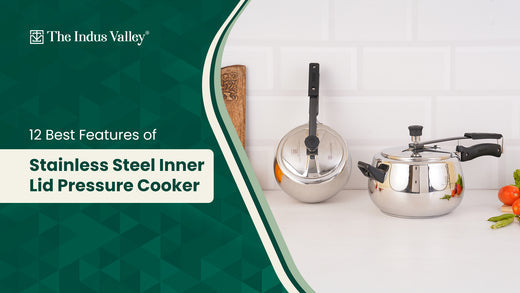


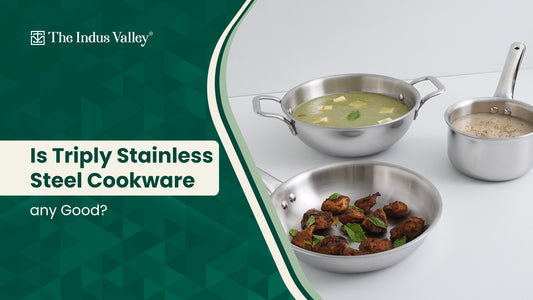
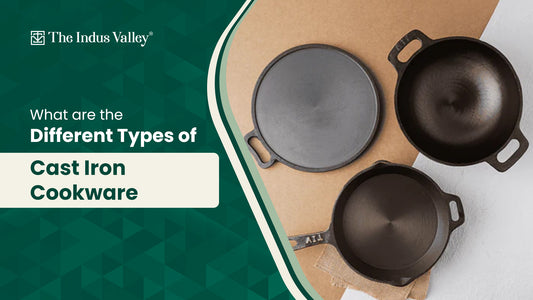
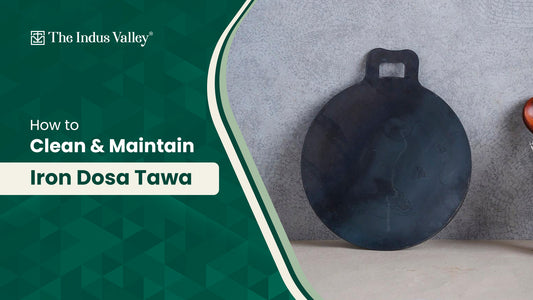





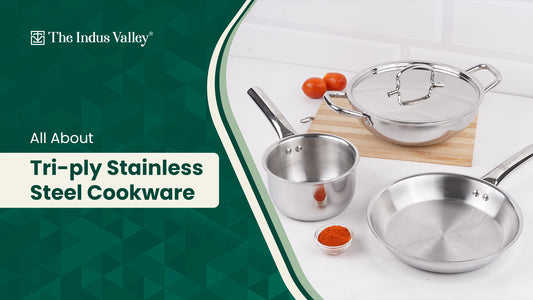


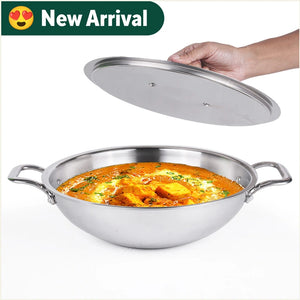
![Neem Wood Spatulas for cooking & Serving – Thick, Long, Sturdy, Large [Set of 6] (Round Serve) - The Indus Valley](http://www.theindusvalley.in/cdn/shop/files/neem-wood-spatulas-for-cooking-and-serving-thick-long-sturdy-large-set-of-6-round-serve-the-indus-valley-1_fcf2cb78-6504-4601-8062-5df2233000c1_300x.jpg?v=1686290651)


